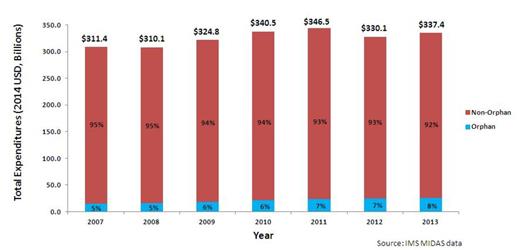Abstract
Introduction: The Orphan Drug Act (ODA) of 1983 established incentives for the development of drugs that treat rare or orphan diseases. The ODA targets therapies for diseases affecting fewer than 200,000 patients in the US. As a consequence, orphan drug development was stimulated and therapies have been developed to treat a variety of previously underserved conditions including acute myeloid leukemia, chronic lymphocytic leukemia, multiple myeloma, myelodysplastic syndromes, Gaucher disease and Hunter syndrome. Between 1973 to 1983, prior to the ODA, less than 10 drugs for orphan conditions were available to patients, while in 2013 the FDA website listed more than 400 approved orphan drugs (this includes both new molecular entities and supplemental applications/indications). Due to the perceived high therapy costs and therefore potential impact on payer's drug budgets, orphan drugs are facing increasing scrutiny from payers. The objective of this study was to estimate the total annual expenditures on orphan drugs in the US from 2007 to 2013, and to evaluate orphan drug expenditures as a percentage of total pharmaceutical expenditures.
Methods: A list of drugs which have been approved by the FDA and given orphan status in the US since the establishment of the ODA through the end of 2013 was generated from the US FDA Orphan Drug Product designation website (N=366 unique products). Only branded products (N=357) were considered in this analysis. The IMS MIDAS database, the gold standard for audited biopharmaceutical sales, was used to assess orphan drug and total drug expenditures. The MIDAS database integrates and extends the IMS National Prescription Audits, which detail estimated sales by product and therapy class through retail and non-retail channels at the unit of the product pack level. The analysis focused on orphan drugs with expenditures measured between 2007 and 2013 in the MIDAS database. Only products with a single orphan indication or with multiple indications which were all orphan were included in the analysis (N=303). Total orphan drug expenditures were calculated annually from 2007 to 2013 and further reported as a proportion of total annual pharmaceutical drug expenditures. All expenditures were adjusted to 2014 USD using the Bureau of Economic Analysis GDP deflator. Expenditures for orphan drugs with cancer indications were evaluated as a subset of all orphan drugs.
Results: Between 2007 and 2013, expenditures were measured for a final N=266 branded orphan drugs in the MIDAS database; 37 out of 303 were either not present or had no sales in MIDAS. Orphan drug expenditures totaled $15.0 billion (B) in 2007 and $25.6B in 2013, representing 4.8% to 7.6% of total U.S. pharmaceutical drug expenditures in 2007 and 2013, respectively (Figure 1). There were 74 (27.8%) orphan drugs identified with an orphan cancer indication with expenditures representing 26.7% (2007) and 34.8% (2013) of total orphan drug expenditures. Over the same period (2007–2013), a total of 145 orphan drugs were granted approval (both new molecular entities and supplemental applications/indications).
Conclusions: Although the ODA has led to an increase in the number of approved orphan drugs and the annual expenditures on orphan drugs, the overall budget impact of orphan drugs is relatively small and has remained fairly stable as a proportion of total pharmaceutical expenditures. Concerns that growth in orphan drug expenditures may lead to unsustainable drug expenditures do not appear to be justified.
Proportion of Total US Drug Expenditures, 2007-2013: Orphan and Non-Orphan Drugs
Proportion of Total US Drug Expenditures, 2007-2013: Orphan and Non-Orphan Drugs
Divino:IMS Health: Employment. Dekoven:IMS Health: Employment. Wang:MKTXS: Employment. Kleinrock:IMS Health: Employment. Harvey:Celgene, Millennium, Onyx and Novartis: Research Funding. Wade:IMS Health: Employment. Kaura:Celgene: Employment, Equity Ownership.
Author notes
Asterisk with author names denotes non-ASH members.


